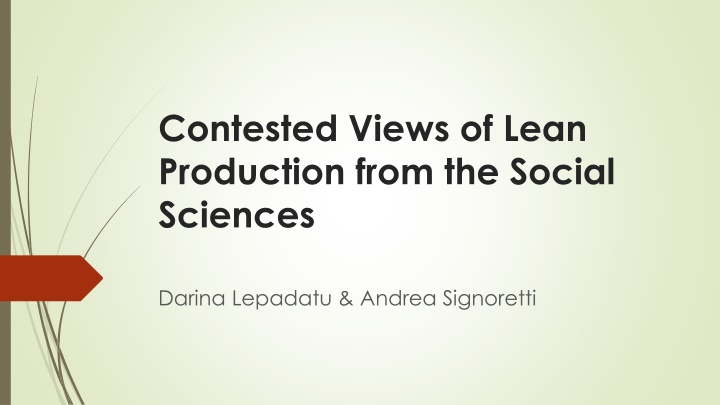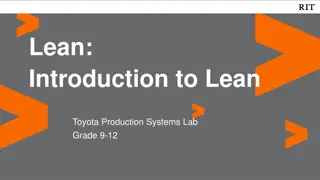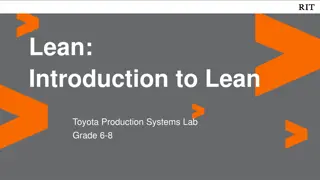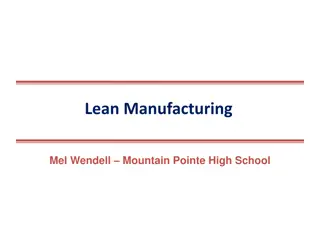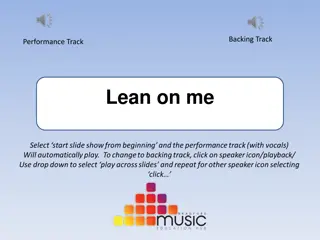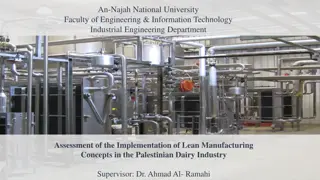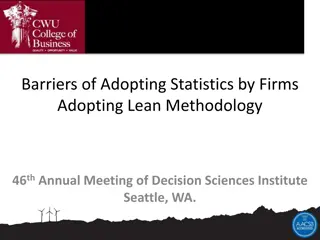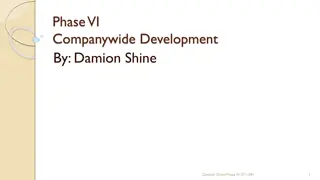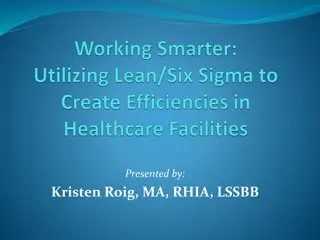Perspectives on Lean Production in Social Sciences
Lean production in the social sciences is explored through various perspectives including hard and soft aspects, sociological viewpoints, socio-technical theory, diffusion of lean production, and critical approaches. The discussion covers elements such as industrial engineering, teamwork, societal implications, and post-Fordism considerations. Key themes include the interplay between social and technical aspects, management strategies, union involvement, and the evolving nature of blue-collar work in lean systems.
Download Presentation

Please find below an Image/Link to download the presentation.
The content on the website is provided AS IS for your information and personal use only. It may not be sold, licensed, or shared on other websites without obtaining consent from the author.If you encounter any issues during the download, it is possible that the publisher has removed the file from their server.
You are allowed to download the files provided on this website for personal or commercial use, subject to the condition that they are used lawfully. All files are the property of their respective owners.
The content on the website is provided AS IS for your information and personal use only. It may not be sold, licensed, or shared on other websites without obtaining consent from the author.
E N D
Presentation Transcript
Contested Views of Lean Production from the Social Sciences Darina Lepadatu & Andrea Signoretti
What is Lean Production? Hard Aspects of Lean (Industrial Engineering) Just in Time Inventory Standardization and Job Rotation Continuous Improvement Soft Aspects of Lean (Social Side of Lean) Long-term Orientation Teamwork Temporary Workers (Deming 1986; Liker, 2004; Liker & Ogden, 2011; Lepadatu & Janoski, 2011; Janoski & Lepadatu; 2013; Besser, 1996)
Sociological Perspectives on Lean Ronald Dore (1973); Robert Cole Japanese Blue Collar (1971) Terry Besser Team Toyota (1993) Lincoln & Kalleberg (1985, 1990, 1996, 2011): welfare corporatism Jeffrey Liker: Team Toyota (2004) Lepadatu & Janoski (2011): gender, race, age and temporary status
Socio-Technical Theory Lewin, Emery and Trist/ Tavistock Institute, London Interaction between social and technical aspects Joint optimization of both social and technical systems Semi-autonomous teams increased productivity and decreased absenteeism The significance of teams for responsible autonomy and adaptability Relaxation of managerial control Work design committees
The Diffusion of Lean Production Countries with strong auto industry have faster lean implementation 43% employees work in lean production systems in EU and US Considerable diffusion of lean in BRICS countries (Jurgens & Krzywdzinski 2016) The significance of management in implementing lean (participative vs authoritarian) The controversial aspect of unions (Signoretti 2016)
Critical approaches to lean Post-Fordism (Harvey, 1991) and flexible accumulation (Vallas, 1999, 2003, 2006) Specialized employees permanent and temporary blue- collar workers Trade unions no longer represent the post-Fordist workforce More blue-collar workers are involved in teams
Critical approaches to lean Regulation school (Jessop, 2001) and Productive models theory (Boyer and Freyssenet, 2002) The Toyotan and Hondian models (Freyssenet 2009) Toyota and the permanent reductions in costs strategy Honda and an innovation and flexibility strategy . The two Japanese companies as more similar than different
Critical approaches to lean Diversified quality production (DQP) (Janoski 1990; Sorge and Streeck 2018) The fall of communism, the unification of Germany and the rise of neo-liberalism (Baccaro et al. 2018; J rgens 2004) Regulation shows the largest change.
Part I: Theories of Lean Production Management Industrial Engineering Industrial Relations Social Sciences Lean Labor Process Part II: Lean Across Industries Auto Industry Telecommunications Healthcare Legal Services Public Sector Merchandising/ Retail Banking and Financing IT/ Software
Part III Lean Around the World US UK Germany France China South Korea India Australia Mexico Russia
Case Studies of Top Lean Orgs Ideal Lean Models: Toyota Honda Semi-Lean: Ford Nissan Lean at Home, Fordist offshoring: Nike, Apple, Google Merchandizing: Walmart, Costco & Amazon
